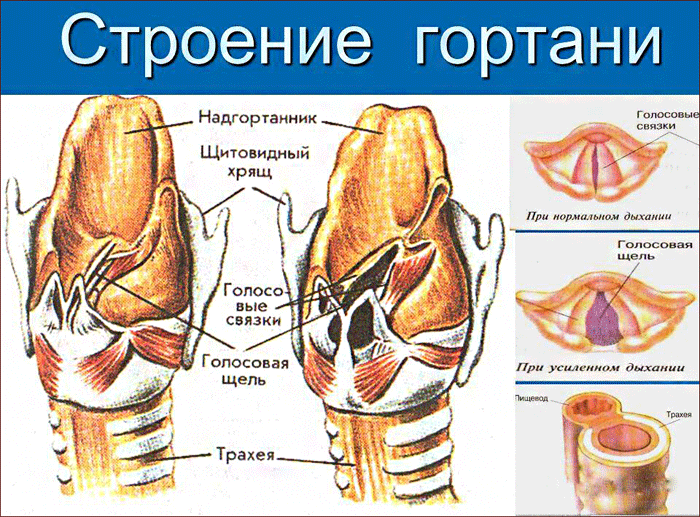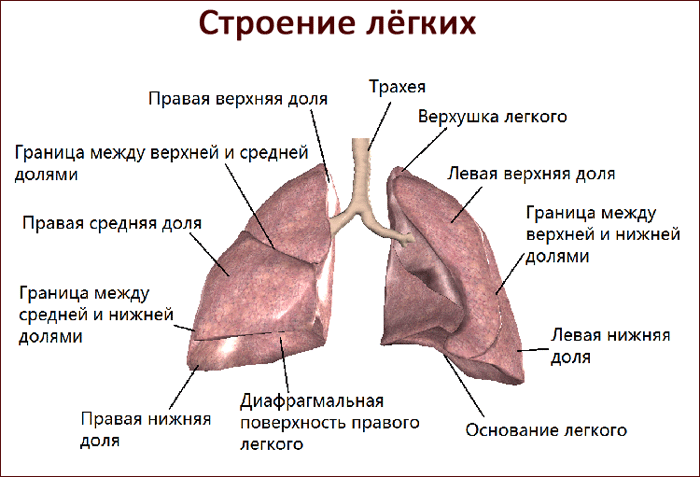The device of the upper and lower respiratory tract in humans
The human respiratory system is a collection of organs necessary for proper breathing and gas exchange. It included the upper respiratory tract and the lower ones, between which there is a conditional boundary. The respiratory system functions 24 hours a day, increasing its activity during motor activity, physical or emotional stress.
Appointment of organs included in the upper respiratory tract
The upper respiratory tract includes several important organs:
- Nose, nasal cavity.
- Throat.
- Larynx.
The upper respiratory system is the first to take part in the processing of inhaled air currents. It is here that the initial purification and warming of the incoming air is carried out. Then there is its further transition to the lower paths to participate in important processes.
Nose and nasal cavity
The human nose consists of a bone that forms its back, lateral wings and a tip based on flexible septal cartilage. The nasal cavity is represented by an air channel that communicates with the external environment through the nostrils, and is connected behind the nasopharynx. This section consists of bone, cartilage tissue, separated from the oral cavity with the help of hard and soft palate. The inside of the nasal cavity is covered with a mucous membrane.
Proper functioning of the nose ensures:
- purification of the inhaled air from foreign inclusions;
- neutralization of pathogenic microorganisms (this is due to the presence of a special substance in the nasal mucus - lysozyme);
- humidification and warming of the air flow.
In addition to breathing, this area of the upper respiratory tract performs an olfactory function, and is responsible for the perception of various aromas. This process occurs due to the presence of a special olfactory epithelium.
An important function of the nasal cavity is an auxiliary role in the process of voice resonation.
Nasal breathing provides disinfection and warming of the air. In the process of breathing through the mouth, such processes are absent, which, in turn, leads to the development of bronchopulmonary pathologies (mainly in children).
Functions of the pharynx
The pharynx is the back of the throat into which the nasal cavity passes. It looks like a funnel-shaped tube 12-14 cm long. The pharynx is formed by 2 types of tissue - muscular and fibrous. From the inside, it also has a mucous membrane.
The pharynx consists of 3 sections:
- Nasopharynx.
- Oropharynx.
- hypopharynx.
The function of the nasopharynx is to ensure the movement of air that is inhaled through the nose. This department has a message with the ear canals. It contains adenoids, consisting of lymphoid tissue, which take part in filtering the air from harmful particles, maintaining immunity.
The oropharynx serves as a pathway for air to pass through the mouth in case of breathing. This section of the upper respiratory tract is also intended for eating. The oropharynx contains the tonsils, which, together with the adenoids, support the protective function of the body.
Food masses pass through the laryngopharynx, entering further into the esophagus and stomach. This part of the pharynx begins in the region of 4-5 vertebrae, and gradually passes into the esophagus.
What is the importance of the larynx
The larynx is an organ of the upper respiratory tract involved in the processes of respiration and voice formation. It is arranged like a short tube, occupies a position opposite 4-6 cervical vertebrae.
The anterior part of the larynx is formed by the hyoid muscles. In the upper region is the hyoid bone. Laterally, the larynx borders on the thyroid gland. The skeleton of this organ consists of unpaired and paired cartilages connected by joints, ligaments and muscles.
The human larynx is divided into 3 sections:
- Upper, called the vestibule. This area is stretched from the vestibular folds to the epiglottis. Within its limits there are folds of the mucous membrane, between them there is a vestibular fissure.
- The middle (interventricular section), the narrowest part of which, the glottis, consists of intercartilaginous and membranous tissue.
- Lower (sub-vocal), occupying the area under the glottis. Expanding, this section passes into the trachea.

The larynx consists of several membranes - mucous, fibrocartilaginous and connective tissue, connecting it with other cervical structures.
This body has 3 main functions:
- respiratory - contracting and expanding, the glottis contributes to the correct direction of the inhaled air;
- protective - the mucous membrane of the larynx includes nerve endings that cause a protective cough if food is not properly ingested;
- voice-forming - the timbre and other characteristics of the voice are determined by the individual anatomical structure, the state of the vocal cords.
The larynx is considered an important organ responsible for the production of speech.
Some disorders in the functioning of the larynx can pose a threat to health and even human life. These phenomena include laryngospasm - a sharp contraction of the muscles of this organ, leading to complete closure of the glottis and the development of inspiratory dyspnea.
The principle of the device and operation of the lower respiratory tract
The lower respiratory tract includes the trachea, bronchi, and lungs. These organs form the final section of the respiratory system, serve to transport air and carry out gas exchange.
Trachea
The trachea (windpipe) is an important part of the lower respiratory tract that connects the larynx to the bronchi. This organ is formed by arcuate tracheal cartilages, the number of which in different people ranges from 16 to 20 pieces. The length of the trachea is also not the same, and can reach 9-15 cm. The place where this organ begins is at the level of the 6th cervical vertebra, near the cricoid cartilage.
The windpipe includes glands, the secret of which is necessary for the destruction of harmful microorganisms. In the lower part of the trachea, in the region of the 5th vertebra of the sternum, it is divided into 2 bronchi.
In the structure of the trachea, 4 different layers are found:
- The mucous membrane is in the form of a stratified ciliated epithelium lying on the basement membrane. It consists of stem, goblet cells that secrete a small amount of mucus, as well as cellular structures that produce norepinephrine and serotonin.
- Submucosal layer, which looks like loose connective tissue. It contains many small vessels and nerve fibers responsible for blood supply and regulation.
- The cartilaginous part, which contains hyaline cartilages connected to each other by means of ring ligaments. Behind them is a membrane connected to the esophagus (due to its presence, the respiratory process is not disturbed during the passage of food).
- The adventitia is a thin connective tissue that covers the outside of the tube.
The main function of the trachea is to carry air to both lungs. The windpipe also performs a protective role - if foreign small structures enter it together with air, they are enveloped in mucus. Further, with the help of cilia, foreign bodies are pushed into the region of the larynx, and enter the pharynx.
The larynx partially provides warming of the inhaled air, and also participates in the process of voice formation (by pushing air flows to the vocal cords).
How are bronchi arranged?
The bronchi are a continuation of the trachea. The right bronchus is considered the main one. It is located more vertically, in comparison with the left one it has a large size and thickness. The structure of this organ consists of arcuate cartilage.
The area where the main bronchi enter the lungs is called the "gate". Further, they branch into smaller structures - bronchioles (in turn, they pass into alveoli - the smallest spherical sacs surrounded by vessels). All "branches" of the bronchi, having different diameters, are combined under the term "bronchial tree".
The walls of the bronchi are composed of several layers:
- external (adventitious), including connective tissue;
- fibrocartilaginous;
- submucosal, which is based on loose fibrous tissue.
The inner layer is mucous, includes muscles and cylindrical epithelium.
The bronchi perform essential functions in the body:
- Deliver air masses to the lungs.
- Purify, humidify and warm the air inhaled by a person.
- Support the functioning of the immune system.
This organ largely ensures the formation of a cough reflex, due to which small foreign bodies, dust and harmful microbes are removed from the body.
The final organ of the respiratory system is the lungs.
A distinctive feature of the structure of the lungs is the pair principle. Each lung includes several lobes, the number of which varies (3 in the right and 2 in the left). In addition, they have different shapes and sizes. So, the right lung is wider and shorter, while the left, closely adjacent to the heart, is narrower and elongated.

The paired organ completes the respiratory system, densely penetrated by the "branches" of the bronchial tree. In the alveoli of the lungs, vital gas exchange processes are carried out. Their essence lies in the processing of oxygen entering during inhalation into carbon dioxide, which is excreted into the external environment with exhalation.
In addition to providing breathing, the lungs perform other important functions in the body:
- maintain the acid-base balance within the acceptable range;
- take part in the removal of alcohol vapors, various toxins, ethers;
- participate in the elimination of excess fluid, evaporate up to 0.5 liters of water per day;
- help complete blood clotting (coagulation);
- involved in the functioning of the immune system.
Doctors state that with age, the functionality of the upper and lower respiratory tract is limited. The gradual aging of the body leads to a decrease in the level of lung ventilation, a decrease in the depth of breathing. The shape of the chest, the degree of its mobility also changes.
In order to avoid early weakening of the respiratory system and to maximize its full-fledged functions, it is recommended to stop smoking, alcohol abuse, a sedentary lifestyle, and to carry out timely, high-quality treatment of infectious and viral diseases that affect the upper and lower respiratory tract.
